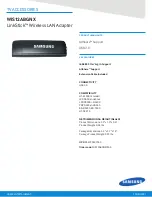
6.9 Troubleshooting without Fault Display
This section describes troubleshooting problems that do not trip an alarm or fault.
u
Cannot Change Parameter Settings
Cause
Possible Solutions
The drive is running the motor (i.e., the Run command
is present).
• Stop the drive and switch over to the Programming Mode.
• Most parameters cannot be edited during run.
The Access Level is set to restrict access to parameter
settings.
• Set the Access Level to allow parameters to be edited (A1-01 = 2).
The operator is not in the Parameter Setup Mode (the
LED screen will display “PAr”).
• See what mode the LED parameter is current set for.
• Parameters cannot be edited when in the Setup Mode (“STUP”). Switch modes so that “PAr”
appears on the screen.
A multi-function contact input terminal is set to allow
or restrict parameter editing (H1-01 through H1-06 =
1B).
• When the terminal is open, parameters cannot be edited.
• Turn on the multi-function contact input set to 1B.
The wrong password was entered.
• If the password entered to A1-04 does not match the password saved to A1-05, then drive
settings cannot be changed.
• Reset the password.
If you cannot remember the password:
•
Display parameter A1-04. Press the
STOP
button while pressing
at the same time.
Parameter A1-05 will appear.
• Set a new password to parameter A1-05.
Undervoltage was detected.
• Check the drive input power voltage by looking at the DC bus voltage (U1-07).
• Check all main circuit wiring.
u
Motor Does Not Rotate Properly after Pressing RUN Button or after Entering External
Run Command
n
Motor Does Not Rotate
Cause
Possible Solutions
The drive is not in the Drive
Mode.
• Check if the DRV light on the LED operator is lit.
• Enter the Drive Mode to begin operating the motor.
Refer to The Drive and Programming Modes on page 70
.
The
button was pushed.
Stop the drive and check if the correct frequency reference source is selected. If the operator keypad shall be the
source, the LO/RE button LED must be on, if the source is REMOTE, it must be off.
Take the following steps to solve the problem:
•
Push the
button.
• If o2-01 is set to 0, then the LO/RE button will be disabled.
Auto-Tuning has just completed.
• When Auto-Tuning has completed, the drive is switched back to the Programming Mode. The Run command
will not be accepted unless the drive is in the Drive Mode.
• Use the LED operator to enter the Drive Mode.
Refer to The Drive and Programming Modes on page 70
.
A Fast-Stop was executed and
has not yet been reset.
Reset the Fast-Stop command.
Settings are incorrect for the
source that provides the run
command.
Check parameter b1-02 (Run Command Selection).
Set b1-02 so that it corresponds with the correct run command source.
0: LED/LCD operator
1: Control circuit terminal (default setting)
2: MEMOBUS/Modbus communications
3: Option card
One of the Safety Inputs is open.
• Check for a short-circuit between terminals H1 and HC.
• See if one of the Safety Inputs is open.
• Correct any faulty wiring.
There is faulty wiring in the
control circuit terminals.
• Check the wiring for the control terminal.
• Correct wiring mistakes.
• Check the input terminal status monitor (U1-10).
The drive has been set to accept
the frequency reference from the
incorrect source.
Check parameter b1-01 (Frequency Reference Selection 1).
Set b1-01 to the correct source of the frequency reference.
0: LED operator
1: Control circuit terminal (default setting)
2: MEMOBUS/Modbus communications
3: Option card
4: Pulse train input (RP)
The terminal set to accept the
main speed reference is set to the
incorrect voltage and/or current.
If the frequency reference is set at terminal A1, check parameter H3-01 for the correct signal level selection. If
terminal A2 is used, check DIP switch S1. Then select the correct input level for terminal A2 in parameter H3-08.
Refer to DIP Switch S1 Analog Input Signal Selection on page 57
.
Selection for the sink/source
mode is incorrect.
Check DIP switch S3.
Refer to Sinking/Sourcing Mode Switch on page 55
.
Frequency reference is too low. • Check the frequency reference monitor (U1-01).
• Increase the frequency by changing the maximum output frequency (E1-09).
6.9 Troubleshooting without Fault Display
SIEP C710606 20 OYMC AC Drive - V1000 User Manual
253
6
Troubleshooting
7/16/2008-13:23
















































